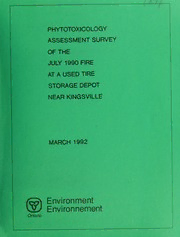
Phytotoxicology assessment survey of the July 1990 fire at a used tire storage depot near Kingsville : report PDF
Preview Phytotoxicology assessment survey of the July 1990 fire at a used tire storage depot near Kingsville : report
UU- r PHYTOTOXICOLOGY ASSESSMENT SURVEY OF THE JULY 1990 FIRE AT A USED TIRE STORAGE DEPOT NEAR KINGSVILLE MARCH 1992 Environment Environnement Ontario ISBN 0-7729-9311-4 PHYTOTOXICOLOGY ASSESSMENT SURVEY OF THE JULY 1990 HRE AT A USED TIRE STORAGE DEPOT NEAR KINGSVILLE Report Prepared By: William I. Gizyn Phytotoxicology Section Air Resources Branch Ontario Ministry ofthe Environment MARCH 1992 o PRINTEDON RECYCLEDPAPER IMPRIMESUR DUPAPIERRECYCLE Cette publication technique n'est disponible qu'en anglais. Copyright: Queen's Printer forOntario, 1992 This publication may be reproduced for non-commercial purposes with appropriate attribution. PIBS 1897 log 91-2231-024 2 Table of Contents 1 Background 1 2 Fire Site Description 1 3 Observations and Sample Collection 1 4 Chemical Analysis Results 4 4.1 Polycyclic Aromatic Hydrocarbons (PAH) 4 4 . Dioxins and Furans 4 4 3 Inorganic Elements 5 . 5 Discussion 6 6 Conclusions 7 . 1 Background On July 15, 1990 between 3:00 AM to 6:00 AM, a fire occurred at a used tire storage yard located approximately 3.5 kilometres west of Kingsville, Ontario. The yard was located near the inter- section of Ontario Highway 18 and McCain Side Road; on Lot 16, Concession 1, Gosfield South Township. The lands surrounding the yard were agricultural fields and pastures. On July 17, 1990, the Phytotoxicology Section received a request from the Ministry of the Environment Windsor District office for an investigative survey to assess possible contamina- tion of crop plants and field soils and potential for productiv- ity losses. It was reported that approximately 4000 tires were involved in the fire. 2 Fire Site Description The tire storage yard consisted of a fenced enclosure 95 metres along the east-west axis and 66 metres along the north- south axis. Several buildings were located immediately east of the yard and included residences and barns. The fence was constructed of vertical wooden planks, two metres in height. The fire was confined to the northwest corner of the yard, where the majority of the tires were located. A highway trailer, which was apparently loaded with tires for shipment to a recycling facil- ity, was consumed in the fire. A section of the fence on the west side of the yard was also consumed. A livestock pasture was located immediately west of the yard. A field planted with soybean was approximately 40 metres north of the yard. There were several areas containing unmanaged vegetation within the yard and immediately outside. Figure 1 illustrates the relative locations of the yard, buildings, roads and fields. This figure also identifies the locations of foliage and soil samples taken during the investiga- tion and discussed in this report. 3 Observations and Sample Collection The Phytotoxicology investigation was conducted on July 17, 1990. By this date, a clean-up, consisting of removal of debris and soil from the fire location, had begun. An examination of the vegetation in the immediate vicinity did not reveal any injury symptoms which could be attributed to fire emissions. Scorched vegetation was present at the west fence line where the fence was consumed. The only other indication, on vegetation, of a fire was the presence of black soot-like deposits on the foliage of grass, wild grape, hawthorn, goldenrod, as well as other species. How- ever, these deposits were restricted to plants in the immediate vicinity of the fire and were not noted beyond 20 metres from the fence Figure 1: Sampling Locations at Kingsville Tire Fire Railway Line , A= SampIIng Site Because the area around the fire site consisted of agricul- tural fields, there was concern that contamination of crops and soil may have occurred. Sampling was conducted to determine the nature of the potential contaminants and their extent. As previously noted, soot-like deposits were observed on vegetation near the fire site. Hawthorn foliage was collected at three locations; immediately west of the west fence (Site 1), 20 mneotrrtehsfweenscte o(fSitthee3)w.estThefseenceloc(aStiitoens2) a,reandind7imceattreedsonnorFtihguroef t1.he . . Two sites for collection of soybean plants and soil were established in the field north of the yard. Both sites were five metres from the edge of the field. One was due north of the fire (Site 4) while the other was to the northeast (Site 5) In addition to these samples collected in the immediate area of the fire, two additional sites were established for the col- lection of soybean plants. These were in a field approximately 500 metres east of the fire (Site 6) , and in a field approximately 600 metres northeast (Site 7) Hawthorn samples consisted of foliage removed from branches facing the fire. Soybean material consisted of whole plants above the soil level. It should be noted that the soybeans were only about 15 centimetres in height. Soil samples were taken from the top one centimetre and from the top 15 centimetres. Special pro- tocols for collection of environmental samples destined for anal- ysis of organic contaminants were followed. These included solvent washing of sampling equipment between samples and using special solvent-washed glass containers. Table 1 summarizes the locations of samples (corresponding to site numbers on the figure) the nature of the sample, and the , respective categories of chemical analyses. Table 4 Chemical Analysis Results All of the above described samples were submitted to various sections of Laboratory Services Branch for analysis. The follow- ing summarizes the results of these analyses. 4 1 Polycyclic Aromatic Hydrocarbons (PAH) . All samples, (hawthorn, soybean and soil) were subjected to an analysis of the PAH's listed in Table 2; The limits of detection, in micrograms per gram (ug/g) dry weight, are also indicated. Table 2: Detection Limits for PAH
